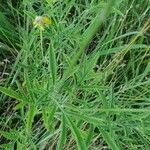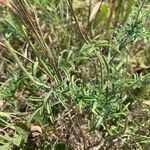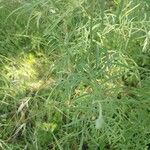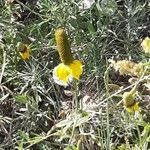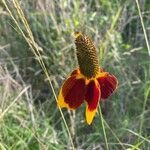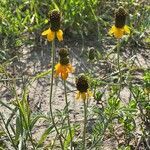Taprooted, with clustered stems 3-12 dm, strigose or partly hirsute, generally leafy to above the middle; lvs pinnatifid or partly bipinnatifid, the ultimate segments linear or lanceolate, entire or nearly so, relatively few and often very unequal, generally many of or all them 1.5 cm or more; heads (1-)several or many, naked-pedunculate, the disk columnar, 1.5-4.5 cm, 2-4.5 times as long as thick; rays yellow or (f. pulcherrima (DC.) Fernald) partly or wholly brown-purple, 1-3.5 cm, spreading or reflexed; style-appendages very short and blunt; achenes with the inner margin fringed-ciliate to nearly smooth, usually slightly winged; pappus an evident awn-tooth on the inner angle of the achene, and often also a shorter one on the other angle; 2n=26, 27, 28, 34-38. Prairies and other dry, open places; Minn. to Mo. and La., w. to Mont., Tex., and n. Mex., and occasionally intr. e. June-Aug. Taprooted, with clustered stems 3-12 dm, strigose or partly hirsute, generally leafy to above the middle; lvs pinnatifid or partly bipinnatifid, the ultimate segments linear or lanceolate, entire or nearly so, relatively few and often very unequal, generally many of or all them 1.5 cm or more; heads (1-)several or many, naked-pedunculate, the disk columnar, 1.5-4.5 cm, 2-4.5 times as long as thick; rays yellow or (f. pulcherrima (DC.) Fernald) partly or wholly brown-purple, 1-3.5 cm, spreading or reflexed; style-appendages very short and blunt; achenes with the inner margin fringed-ciliate to nearly smooth, usually slightly winged; pappus an evident awn-tooth on the inner angle of the achene, and often also a shorter one on the other angle; 2n=26, 27, 28, 34-38. Prairies and other dry, open places; Minn. to Mo. and La., w. to Mont., Tex., and n. Mex., and occasionally intr. e. June-Aug.
More
Perennials, to 105+ cm; taprooted. Leaves 2–15+ × 0.8–6 cm, 1–2-pinnatifid, lobes 3–14, narrowly linear-lanceolate to narrowly oblong-ovate, 1–16 mm wide, faces hirsute, gland-dotted. Heads 1–15, held well beyond leaves. Peduncles (1.5–)6.5–48+ cm (ribs tan, prominent). Phyllaries 5–14, outer linear, 4–14 × 0.5–2 mm, inner lanceolate-ovate, 0.8–3 × 0.8–2 mm. Paleae 2.3–3.5 × 0.5–3 mm, resin glands oval-oblanceolate, 0.6–1.5 mm. Ray florets 4–12; corollas yellow, purplish yellow, or maroon, sometimes bicolor (maroon/yellow), laminae lanceolate-ovate to elliptic-oblanceolate, 7–35 × 4–17 mm. Discs columnar, 10–50 × 7–12 mm. Disc florets 200–400+; corollas greenish yellow, often purplish distally, 1–2.5 mm; style branches 0.5–1.4 mm, proximal 2/3–3/4 stigmatic, apices rounded. Cypselae oblong, 1.2–3 × 1.2–2 mm, abaxial margins glabrous, adaxial margins and apices glabrous or ciliate; pappi (tan) usually of 1–2 toothlike projections, sometimes 0. 2n = 28.
A daisy family plant that keeps growing from year to year. It grows 60 cm high and spreads 45 cm wide. The leaves are alternate and deeply divided into narrow segments. They are 5-10 cm long. The flowers are yellow disks. The flowers heads occur as several together in cone like disks. They are 1-5 cm high. The fruit is a grey-black flattened achene.
